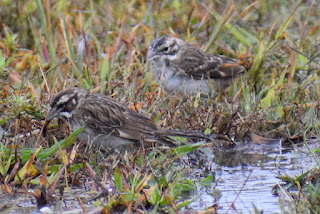Local Rarities and fall specialties
Since the start of October, I have turned my birding attention to mostly Island Beach State Park. My years of birding there have shown that October is the best time to find local rarities like American golden-plover, Baird’s sandpiper and lark sparrow, or fall specials like jaegers. This October has not disappointed me because not only did I find all of these species so far this month, but I also added a black-headed gull to my park list.
Back on October 3, I found a pair of lark sparrows in a grass field just outside of the park’s main gate. This field hosts a weekly farmer’s market during the summer, but in the fall, sparrows enjoy the vacated lot. In past seasons there have been clay-colored sparrows, dickcissels and meadowlarks occasionally mixing in with the regular song sparrows, white-throated sparrows, chipping sparrows and dark-eyed juncos. The lark sparrows, along with a clay-colored sparrow, lingered at the field for several days to allow other birders to add them to their year or life lists.
Continuing south down the beach I picked up my first western sandpiper of the year. When I reached the southern end of the park at Barnegat Inlet, I spotted a couple of white-rumped sandpipers on the north jetty, three to be exact. But when what kind of looked like a fourth one, again looked just different enough for me to take pictures to examine it a little more in depth. This bird seemed to be a little more buffy in its chest and its folded wing primaries seemed to project slightly more beyond its tail than the other white-rumpeds, suggesting a Baird’s sandpiper. I texted the photos to a few friends I considered more adept at identifying this bird. Their individual reviews were unanimous that I indeed found my second lifetime Baird’s sandpiper, both October beach birds.
This past week I noticed that seabird activity had picked up with the fall glut of bait fish along the beach. Laughing gulls and the remaining Forster’s terns were building in numbers and feeding on the bait. This activity is conducive to finding a jaeger off the beach. Jaegers are pelagic seabirds, but occasionally parasitic jaegers meander close to shore targeting the smaller gulls and terns. Like mid-air pirates, they zip in on the unsuspecting birds and try to separate them from their freshly caught food. After a few days of looking and waiting I finally saw a long-winged gull-like bird swoop in on a pair of laughing gulls in midair. The gulls had already swallowed their food by the time the jaeger buzzed them. It turned on a dime and made a bee line at a flock of terns resting on the water, scattering them in all directions. The jaeger continued north and out of sight just as quickly as it had appeared.
The next day I took my friends Scott and Linda along the beach in hopes of finding another jaeger. The gulls were still plentiful and actively feeding on bait, but we could not spot a jaeger. However, with his usual keenness, Scott identified a black-headed gull mixed in with the laughing gulls feeding out on the ocean. It was a smaller, mostly white gull similar to a Bonaparte’s gull, which also were around. But we were able to make out its orange legs and dark underwing primaries to make the correct identification. This was my first for Island Beach and, to my knowledge (and research), only the second seen at the park.
Not a bad October so far.











Comments
Post a Comment